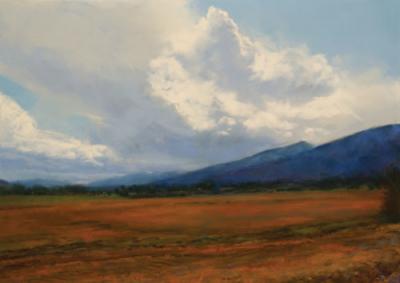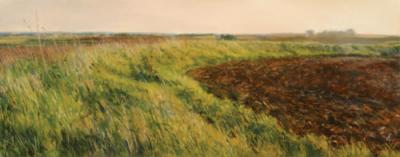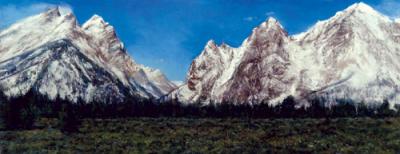Montana Artist Bobbie McKibbin

Seen from a distance, they appear to be enlarged photographs, snapshots of quiet pastoral scenes and dramatic backcountry vistas blown up to cover the gallery walls, each image a finely composed thought, caught in the narrow sleeve of the present, the bottleneck of the now. Viewed from a few feet away, they become entirely abstract, the mark making bold and lively and vigorous impressions (like the artist), with great gallant colors that could have come from the palette of Joan Mitchell or the hand of de Kooning. It is from the middle distance, however, that the drawings are the most rewarding, engendered by and engendering of the landscapes they so faithfully depict, the elements of time and silence interbreeding with confidence and technical fluency to produce a visual potpourri that instills thought, lowers the blood pressure, and provides a sense of belonging.
Herein lies the object of art: to bring us the truth. In the case of Bitterroot pastel artist, Bobbie McKibbin, it is the truth of our flower gardens, the back roads we drive, the rain storms, corn fields, and mountain ranges that populate our lives. After an operation to save her from potential blindness in her 20s, it became McKibbin’s mission to record these scenes, to remind us of the incalculable beauty that surrounds each day. Recently retired from 31 years of teaching at Grinnell College in Iowa, she now resides full-time in Stevensville, transcribing the quiet truths of the landscape with a kaleidoscope of chalk, a quantity of verve, and a deep well of experience.
McKibbin’s work hangs in more than 50 corporate collections and 10 museums, including the Brunnier Art Museum and National Museum of American Art at the Smithsonian Institution. John Canaday, former New York Times Art Critic and author of Mainstreams in Modern Art, has written about McKibbin, saying, “McKibbin impresses me as exceptionally skillful technically...and sensitive to the kind of interpretative values in subject matter that make the difference between skillful rendition and significant art. McKibbin finds in the most commonplace views of daily American life a native poetry that is all the more effective for their subtly controlled understatement.” He has gone on to call her, “a cross between Sargent’s fluency with the brush and Hopper’s sensitivity to his subjects.”
With the natural world as her starting point, beauty her stock in trade, what McKibbin draws is not simply a scene, but the time of day, the fragility or density of the light, even the air temperature. In her work, you can sense the solemnity of the morning, the sagging laziness of flowers at noon, or the near churchlike holiness of the mountains. Even if you have never visited one of the landscapes McKibbin draws, there is frequently a déjà vu experience when encountering her drawings. Intuitively you know she has got it right. It feels as if you have been there. Scrape away the obvious dexterity and what is revealed in a McKibbin is not only the ridiculously beautiful place we live, but also an underlying sensitivity to the composite idea of nature, its corporeal and fissiparous relationship with the government of time.

McKibbin grew up in Philadelphia; the landscape of her childhood was row houses. Yellowstone, the Grand Canyon, the overbite of the Tetons had to be found inside her brother Alex’s ImageFinder. McKibbin came from an artistic family, her father a photo retoucher for the Philadelphia Enquirer, and Alex, 10 years her senior, an accomplished painter. It was Alex who brought her to the Philadelphia Museum of Art where, “I remember standing in front of Picasso’s Three Musicians, the painting,” McKibbin says, “and it just knocked me out. It was a cubist piece and it looked enormous to me, and I thought, ‘My god, a human being made that.’” When McKibbin began making images herself, she says, “I remember holding crayons so tightly that the heat of my hands would bend them. And I’d press down with such a vengeance to try and get as much color out them as possible.” Then she adds, “I’m still pretty heavy handed. Some things never go away.”
Down through the ages artists have functioned as cultural digesters, turning what they find in the outside world into the soul’s manna and the eye’s candy. McKibbin feeds both; yet unlike other landscape artists, she is not trying to lead the viewer anywhere. There is nothing didactic about her work, no pedagogy. What McKibbin asks, if anything, is to “see as I see.”
“I’m not a casual looker,” McKibbin says, “I feel lucky being a visual artist because it strikes me we get so much through visual input, and to have that tuned in, turned on, makes the world—makes life—pretty extraordinary.” At a backyard barbeque once, McKibbin turned to me and without warning said, “Look at you all, sitting here and having a good time. I look around and all I see is work.” With a glass of wine, she pointed over my shoulder to a patch of lawn being raked with low evening light coming through the trees, igniting the green grass. It was beautiful, I admitted, and the point was well taken. I never would have noticed had she not pointed it out.
McKibbin draws the absolutely normal, the everyday scenes we pass by and hardly notice. Her genius comes from making us notice, in waking us up. What could be more mundane and spectacular, her drawings whisper, than a field of flowers bleeding all its color and life—giving all—to the sidelong glance of a passerby, every stamen and pistil pressing itself through the ether, through the looking glass tubes of the retina, waving all those primary colors onto the pleasure centers of the brain. To let that much beauty just slip on by, unrecorded, that is not in the nature of McKibbin.

“Making my images expands me technically and visually,” McKibbin says, “and, by doing so, people who look at my drawings may have their world made a little bigger too. They might notice color a little differently; they might notice the sky is that blue. Is that why I do it? No. But if it happens it’s a nice by-product. Maybe that’s a pretty big deal.”
McKibbin’s longtime partner, Shirley, believes that it is a big deal and has watched McKibbin evolve as an artist. “Bobbie has always been very intense about the commitment of the making of art,” she says. “She lives and breathes the art world in the formal sense of the word, not in the political or contemporary art scene, but by translating the visual into her own world. I don’t think that’s done anything but get deeper. The work she makes now is far more complicated than what she made 30 years ago. She has a stronger desire to communicate to a viewer a sense of place.”
McKibbin looks at the world from a poet’s perspective. She sees Emily Dickenson’s slant of light and draws that. She is a landscape artist, but does not restrict herself to a postcard view of the world. “Lucien Freud could paint anybody and paint a great picture,” she says. “It’s like saying I’m going out to the Tetons because I want to paint great landscapes. Well, I don’t buy that. I think if you’re a landscape painter you can make a great landscape of your front yard.” Which is exactly what McKibbin does, and then does again, and again. McKibbin will draw that front yard, that same road or scene, many times. “I love the idea,” she says, “of what it looks like at night, what it looks like at eight in the morning, in the fall, after a snowstorm. I just go back to the idea that the world is so rich. I mean if you’re doing portraits, everybody has an incredible kisser. If you just work hard enough so that you can record, and you can do it with some degree of confidence or skill, it will be a pretty interesting picture. And even though we’ve seen the person before, you might look at that image, and go, ‘What a mug.’”
McKibbin’s drawings, for all their quietness of the subject matter, are vibrant. “If there’s one thing pastel can be, it can be very vivid colorfully,” she says. “Wolf Kahn worked with pastel and said, ‘These are little sticks of dynamite.’ And they are. The transition is always of interest to me, going from the real world—to the photograph—to the drawing.”

McKibbin draws from photographs she takes. Hundreds of them, thousands. Shoe boxes are stacked up in her studio, and when it comes time for a new set of drawings, she revisits them. “I’ll do a rough cut and go through and pull out any image that I might be slightly interested in and lay out 50 on this counter and let them sit for a while. I’ll just look. Then I’ll go back and connect up some with others and so forth and so on. The process is becoming much more rational and intuitive. I just want to do that one, and if you ask me why, I’ll say, I don’t know. I just may not know. Or I may want to do it just because it’s bright, and I want to see if I can do that.”
“I say this sometimes to myself: ‘Respect the work. Don’t be doing this half-heartedly. It’s way too important.’ Because there’s too much mediocrity around, where people are making things because they have to financially, because they don’t know any better, they don’t want to work that hard, you know, yadda, yadda, yadda. And I certainly don’t ever want to be in that category. Now I know I’m not de Kooning, but what I’m doing is important, if only to me. It’s an honest attempt at doing an honest day’s work.”
McKibbin’s landscapes, for all their integrity, the truth of the scenes, and the mastery of her marks become not a mirror on nature, but the pause at the bottom of an out-breath, the rest between nature’s systole and diastole. It is for this reason the viewer enjoys her work. To stand in front of a McKibbin is to be reminded that places of quiet, exceptional beauty still exist, even abound, and many of them are just outside our door. The poet, Mary Oliver, has made a career out of asking us to open our eyes, narrow our focus, above all to pay attention, gently showing us the way with a smattering of words. McKibbin does the same thing in her western art, with a handful of chalk, and in the process we become more alive, learning that our lives somehow depend on that field of flowers, that falling down barn, that dusty dirt road, all caught and rendered so carefully, so lovingly, in the cross hairs of light and shade, the composting now.
~ Charles Finn is a freelance writer and woodworker, building one-room cabins. His writings have appeared in Big Sky Journal, Montana Quarterly, Montana Magazine and High Country News, among others. He lives in Stevensville with his wife, Joyce Mphande-Finn, and his cat, 42.
Leave a Comment Here
Leave a Comment Here